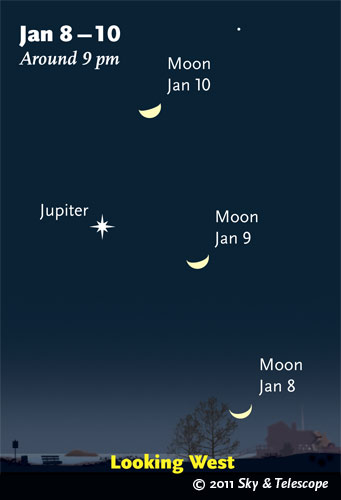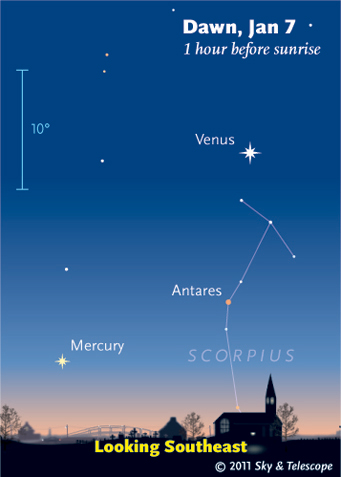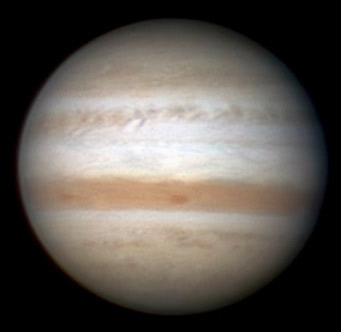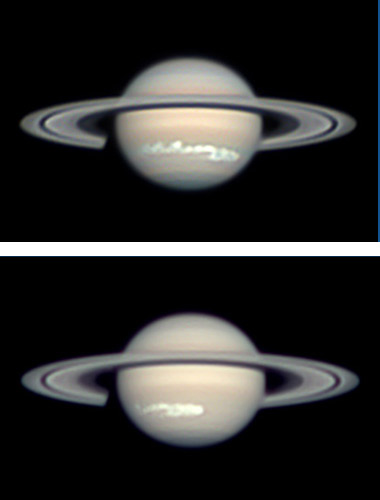Friday, January 7

The waxing Moon currently passes well north of Jupiter. (These scenes are drawn for the middle of North America. European observers: move each Moon symbol a quarter of the way toward the one for the previous date. For clarity, the Moon is shown three times its actual apparent size.)
Sky & Telescope diagram
Saturday, January 8
Sunday, January 9
Monday, January 10
Tuesday, January 11
Wednesday, January 12
Thursday, January 13
Friday, January 14
Saturday, January 15
Sky at a Glance is now an iPhone app! Put S&T SkyWeek on your iPhone, iPad, or iPod Touch and get the above listings anytime, anywhere — with interactive sky maps! Tap a button to see the scene described, customized for your location worldwide. From there you can scroll the view all around the sky, zoom in or out, change to any time or date, and turn on animation. Go to Apple's iTunes store from your device and buy S&T SkyWeek — just 99 cents!
Want to become a better amateur astronomer? Learn your way around the constellations. They're the key to locating everything fainter and deeper to hunt with binoculars or a telescope.
For an easy-to-use constellation guide covering the whole evening sky, use the big monthly map in the center of each issue of Sky & Telescope, the essential magazine of astronomy. Or download our free Getting Started in Astronomy booklet (which only has bimonthly maps).
Sky Atlas 2000.0 (the color Deluxe Edition is shown here) plots 81,312 stars to magnitude 8.5. That includes most of the stars that you can see in a good finderscope, and typically one or two stars that will fall within a 50× telescope's field of view wherever you point. About 2,700 deep-sky objects to hunt are plotted among the stars.
Alan MacRobert
Once you get a telescope, to put it to good use you must have a detailed, large-scale sky atlas (set of charts). The standards are the Pocket Sky Atlas, which shows stars to magnitude 7.6; the larger Sky Atlas 2000.0 (stars to magnitude 8.5); and the even larger and deeper Uranometria 2000.0 (stars to magnitude 9.75). And read how to use your charts effectively.
You'll also want a good deep-sky guidebook, such as Sky Atlas 2000.0 Companion by Strong and Sinnott, or the more detailed and descriptive Night Sky Observer's Guide by Kepple and Sanner, or the classic if dated Burnham's Celestial Handbook.
Can a computerized telescope take their place? I don't think so — not for beginners, anyway, and especially not on mounts that are less than top-quality mechanically. As Terence Dickinson and Alan Dyer say in their Backyard Astronomer's Guide, "A full appreciation of the universe cannot come without developing the skills to find things in the sky and understanding how the sky works. This knowledge comes only by spending time under the stars with star maps in hand."
This Week's Planet Roundup

As the week progresses, Venus will creep down a little toward Mercury, while the starry background including Antares slides toward the upper right. The blue 10° scale is about the width of your fist held at arm's length.
Sky & Telescope diagram
Mercury (magnitude –0.3) is having an excellent morning apparition for skywatchers in the Northern Hemisphere. Look for it low in the east-southeast, far lower left of bright Venus, about 60 to 45 minutes before your local sunrise time. Look also for Antares much closer below below Venus.
Venus (magnitude –4.6) blazes as the "Morning Star" in the southeast before and during dawn. In fact Venus rises some two hours before the first glimmer of dawn (for mid-northern latitudes) — a weird UFO of a thing low in the east-southeast.
Look for Saturn and Spica very far to Venus's upper right in the south, and Arcturus even higher above Venus.
Mars is lost behind the glare of the Sun.
Jupiter (magnitude –2.3, at the Pisces-Aquarius border) shines high in the south as the stars come out, then lower in the southwest later in the evening. Jupiter is the brightest starlike point in the evening sky, but it sets by 10 or 11 p.m. now. In a telescope it has shrunk to only 38 arcseconds wide as Earth rounds to the far side of the Sun from it. But keep watch on Jupiter's South Equatorial Belt re-forming, as dark markings spread east and west around the globe from the storm spot that broke out in the SEB's latitude in November.

Jupiter's South Equatorial Belt (above center) continues to thicken and strengthen, even as Jupiter recedes into the distance for Earthly observers. Note the SEB's ragged, gray appearance compared to the smoother, red-brown North Equatorial Belt. (South is up.)
Christopher Go in the Philippines took this stacked-video image at 10:30 UT January 9, 2011, when the longitude on Jupiter's central meridian was 315° (System II).
Jupiter's Great Red Spot is near System II longitude 157°. Assuming it stays there, here are all of the Great Red Spot's predicted transit times for the rest of this season.
Saturn (magnitude +0.7, in Virgo) rises around midnight but is best seen in a telescope high in the south before dawn (far upper right of brilliant Venus). Don't confuse Saturn with Spica below or lower left of it.
In a telescope, Saturn's new white spot has grown and spread far around the planet! See the pictures below and our article Saturn's New Bright Storm. Here are predicted transit times of the storm's original outbreak site across the center of Saturn's disk.
Saturn's rings, meanwhile, have widened to 10° from edge-on, the widest they've appeared since 2007. And see how many of Saturn's satellites you can identify in your scope using our Saturn's Moons tracker.

If you haven't been watching Saturn before dawn, get out there! Its huge white outbreak, now a month old, has spread far around the planet and is easily visible in amateur telescopes when it's facing Earth — though not so vividly as in these extraordinary images. Don Parker in Florida shot them with a 16-inch reflector and a Luminera Skynyx II-0 camera on the morning of January 2, 2010, at 10:09 and 11:30 UT. "On these images the storm extends from 267° to 325° [System III longitude]," he writes. South is up.
Donald C. Parker
Uranus (magnitude 5.9) remains less than 1½° from Jupiter this week.
Neptune (magnitude 7.9, at the Capricornus-Aquarius border) is sinking into the sunset.
Pluto (magnitude 14, in Sagittarius) is hidden in the background of Mercury in the glow of dawn. Pluto is at its highest in the evening in summer (Northern Hemisphere summer).
All descriptions that relate to your horizon — including the words up, down, right, and left — are written for the world's mid-northern latitudes. Descriptions that also depend on longitude (mainly Moon positions) are for North America. Eastern Standard Time (EST) equals Universal Time (also known as UT, UTC, or GMT) minus 5 hours.
To be sure to get the current Sky at a Glance, bookmark this URL:
http://SkyandTelescope.com/observing/ataglance?1=1
If pictures fail to load, refresh the page. If they still fail to load, change the 1 at the end of the URL to any other character and try again.
 0
0
Comments
You must be logged in to post a comment.